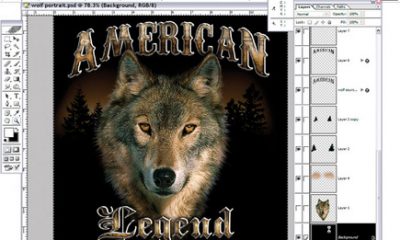Digital Printing
Published
16 years agoon
I recently listened to a podcast on strategies for successful forecasting. One of the gems of that podcast was the idea that strong opinions should be held weakly, meaning that new information and market developments should sway a forecaster’s opinion of what will happen and how fast. I have attended several events since the last time I wrote for Screen Printing magazine that have helped me form new opinions of the fu-ture of the screen- and digital-printing markets.
One of those events was FESPA 2007, held in Berlin, Germany, in June. It was a fantastic demonstration of the latest products from manufacturers from around the world. The attendance at that event was the best it has ever been, accord¬ing to FESPA, and the variety of hardware, inks, and substrates at the show was really very impressive.
Some recent developments, some of which I noted at FESPA, have really changed my perspective on digital printing’s influence on the screen-printing business. The first thing I noticed at FESPA was the tremendous interest in the digital products and services at a show that caters to the screen- and digital-printing market. My view had been that digital printing is making inroads into screen printing primarily in graphics and textiles, where the use of digital printing equipment makes it easier to more cost effectively produce short runs.
The second thing I noticed at FESPA was digital techno-logy’s influence on the four major segments of the screen-printing business: graphics, textiles, specialty/pad printing, and industrial. In addition to the dozens of wide-format graphics printers and digital textile-printing systems at the show, there were several examples of inkjet making an impact on the specialty/pad-printing and industrial-printing markets as well. For example, Sun Chemical and Fujifilm-Sericol/Kammann are running two unique projects in the market for printing optical disks, an area that fits in the industrial category because of the volumes typically run.
These two projects, which are quite different from each other, both bring digital printing to optical-disk marking. Sun Chemical’s work, called Project 37, is basically a UV-curable inkjet printer that can print 1200 optical disks per hour, thereby offering entertainment companies interesting promotional capabilities, such as personalization or regionalization, as well as just-in-time printing.
The Fujifilm Sericol U.S.A./Kammann product is a hybrid screen/UV inkjet printer called the Disc 1204D. It’s also specifically configured for printing on optical disks. The Disc 1204D uses a small screen-printing system to lay a base coat, then uses inkjet printheads to apply UV-curable ink. The printed disks are then cured under Phoseon UV-LED lamps. The Disc 1204D can print up to 2400 discs per hour. These two innovative products represent digital entries into niches of the offset and screen-printing markets, both of which are commonly used to print onto optical disks.
The FESPA show also provided an opportunity to see some of the digital influence on the specialty/pad-printing market. There were numerous examples of UV-curable inkjet printers paired with die cutters or configured as flatbeds that were capable of printing directly onto a range of specialty products like magnets, buttons, badges, plastic parts, labels, and anything else that will lay flat enough. One of the evening events I went to was held by Durst and included a demonstration of the company’s direct-to-glass printing system. It seems that the combination of the ability to print white ink and improved resolution has enabled digital printing to make much greater inroads into the specialty screen-printing market than I would have imagined prior to attending the show.
Graphics printers who yearn for fast digital output found a groundbreaking system in the Onset from Inca Digital. The Onset is huge and expensive at about $3 million, but it is super fast, with rated running speeds at more than 5300 sq ft/hr.
Another standout at FESPA was the first generation of commercially available single-pass wide-format inkjet printers for graphics. The FastJet, co-developed by Sun Chemical and Inca Digital for printing onto sheets of corrugated material, was one such product. The possibilities of single-pass inkjet, which promises to dramatically improve print speeds, are exciting. Other examples of single-pass inkjet that I am aware of include developments from Hewlett-Packard, Memjet, and Kodak.
Of course, a wide array of new textile-printing systems and supplies were also on display at FESPA. Just some of the system manufacturers included companies like Reggiani Macchine S.p.A., Konica Minolta, d.gen, and La Meccanica S.p.A., and all of these new printers are based on printhead technologies deployed in the wide-format-graphics market.
The other event I attended this year was a sales affair for one of the leading suppliers to the screen-printing market. The compelling finding was the excitement the company has about its future. It was clear after speaking to some of the salespeo¬ple, as well as company management, that a big part of their enthusiasm comes from the recognition that there’s a whole range of digital products and services in each of those market segments that they can bring to their customers to help them compete in an industry that continues to augment its screen-printing capabilities with digital printing equipment.
The China issue
Yet another interesting development that I’ve seen has been the way that printing establishments in Europe sometimes deal with the China issue, which should really be called the Asia issue. Many of the printing organizations I spoke to over there indicated that as they work with their clients they have begun to offer what they called “China quality” printing for those jobs that are more price- than quality-sensitive. It was an interesting acknowledgement that their customers are aware that very low priced print-service providers from Asia are doing business over the Internet or through brokers.
This approach seems like the best way to deal with customers or jobs that are price driven, because it allows these printing companies to maintain the relationship with the customers by supplying those “China quality” jobs at a lower price than they offer printing services at their own quality standard. It may also allow the printing company to add some value to their customer relationship by suggesting that they could work with the Chinese printer on the customers’ behalf. This seems like an important development, because it allows one set of printing establishments in Europe to leverage the print capacity of another set of printing establishments that are running in Asia. This being the case, it’s less likely that high-end solvent inkjet printers will be installed in those higher cost areas in Western Europe, because they won’t be able to compete from a cost standpoint for those price-sensitive jobs.
What does it all mean?
For me, all of this new information helps adjust my thinking in constructing models and scenarios for the rate of change in the wide-format market, as well as adjacent businesses. For example, one of the ways that I think about the rate of change is based on the running costs of digital printing technologies. If digital running costs are significantly higher than analog running costs, the rate of change will be slow; the closer they are to analog running costs, the faster the rate of change, depending on other variables, of course, such as target applications, substrate variability, image-quality requirements, and so forth. Well, two of the companies I met with at FESPA—NUR and Matan—have suggested that by using variable-droplet technology and new UV-curable ink formulations, their newest wide-format UV-curable inkjet printers can provide comparable running costs to high-end solvent inkjet printers. If this proves true, then we will have to build greater adoption rates of UV-curable inkjet printers into the forecast.
Tim Greene has worked at InfoTrends (formerly known as CAP Ventures) since 1997 and been the director of InfoTrends' Wide Format Printing Consulting Service since 2001. He is responsible for developing worldwide forecasts of the wide-format-printing market and conducting primary and secondary research. Greene holds a bachelor's degree in management from Northeastern University. He can be reached at tim_greene@infotrends.com.

Subscribe

Magazine
Get the most important news
and business ideas from Screenprinting Magazine.
Most Popular
-

 Case Studies2 months ago
Case Studies2 months agoHigh-Density Inks Help Specialty Printing Take Center Stage
-

 Art, Ad, or Alchemy2 months ago
Art, Ad, or Alchemy2 months agoF&I Printing Is Everywhere!
-

 Andy MacDougall2 months ago
Andy MacDougall2 months agoFunctional and Industrial Printing is EVERYWHERE!
-

 Columns3 weeks ago
Columns3 weeks ago8 Marketing Mistakes Not to Make When Promoting Your Screen Printing Services Online
-

 Editor's Note3 weeks ago
Editor's Note3 weeks agoLivin’ the High Life
-

 Marshall Atkinson3 weeks ago
Marshall Atkinson3 weeks agoHow to Create a Winning Culture in Your Screen-Printing Business
-

 Thomas Trimingham2 months ago
Thomas Trimingham2 months ago“Magic” Marketing for Screen Printing Shops
-

 News & Trends2 months ago
News & Trends2 months agoWhat Are ZALPHAS and How Can You Serve Them in Your Print Business?






